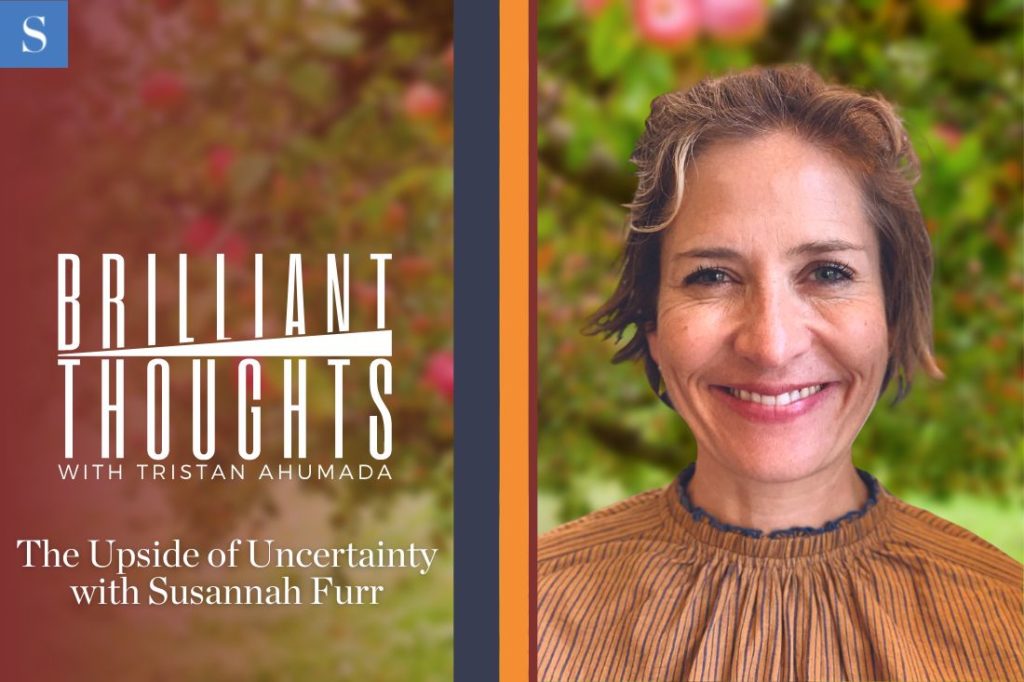The COVID-19 pandemic reminded the world how quickly and drastically things can change. Amid life’s constantly shifting circumstances, it can feel like the only thing you can really count on is relentless uncertainty—which isn’t a comforting thought to most people.
For entrepreneurs, the unpredictable nature of existence presents uniquely frustrating challenges. After all, how do you make costly business decisions without accurate projections? In their newest book, The Upside of Uncertainty, entrepreneurs Susannah Furr and her husband, Nathan Furr, explain that while uncertainty is inevitable, it’s not without its upsides.
“We realized uncertainty is something that happens to us all, and it attacks us on a very fundamental human level of like, ‘Am I okay? Am I going to be okay?’” explains Susannah Furr in a recent interview with Brilliant Thoughts’ editor and host, Tristan Ahumada. “Uncertainty needs to be dealt with first as an individual. So before you can lead a team, you need to know how to navigate it yourself.”
Luckily, no one needs to navigate the unknown alone. Drawing on questions that Nathan encountered while earning his doctorate from the Stanford Technology Ventures Program, Upside delves into four tools for combatting uncertainty: reframe, prime, do and sustain. Each category contains multiple strategies that when thoughtfully and consistently applied, do more than teach survival—they teach you how to thrive.
1. Reframe the way you’re thinking.
Before you can tackle any problem, you have to thoroughly understand the issue. To truly grasp the situation, you have to acknowledge any biases that may be coloring your perspective. That’s why the first tool in the reframe category is framing, a concept in psychology that suggests humans are loss-averse and gain-seeking.
“Anything that feels like a loss we are wired to run from and avoid, and uncertainty always kind of shows up in this loss,” explains Furr. “When we know humans are wired in this way, then we can just kind of step back and go, ‘Okay, I’m human, what I’m doing is normal,’ and then you can start thinking about the other possibilities.”
Another notable tool in the reframe category (which has nine in total) is aplomb, a French word that means stability, composure and confidence. Furr says that despite tremendous success, most visionaries have struggled to maintain aplomb when faced with their own perceived failures.
“Basically, the tool of aplomb is kind of like going rogue on your self doubt, looking at it and trusting that if you’re in a role in your company, or even if you are the one sole person trying to push an idea forward, you’re there for a reason,” she says. “People have believed in you before, so get out of your own way and start thinking, ‘Okay, what can I do today to push this forward?’”
2. Prime yourself for a better outcome.
Are you willing to do the prep work? When combined with reframing, the ability to prime—to prepare for what’s coming—can make uncertainty a lot less daunting. Although it takes time, priming can reveal more possibilities for success and ensure you have a high-quality finished product.
“When you think about priming a room, like with paint, or priming a pump, it’s kind of this really important step so that you really are happy with the outcome,” says Furr. “Preparing is done when you really take some time to have more self-knowledge, so we encourage getting comfortable with your own risk profile.”
Of course, not everyone worries about the same things, so Furr recommends developing a personal risk profile to pinpoint your fears and likelihoods. It involves charting your current and past decisions to better understand where you feel comfortable taking chances, which, at least to Furr, is a necessity for accomplishing something novel.
“Obviously, there are risks you shouldn’t take, but sometimes we hold ourselves back because it’s a risk that we have an aversion for,” she says. “And if we can just push ourselves a little, we can increase our risk ability in that area.”
Another effective priming tool is a technique that many entrepreneurs, business owners and CEOs already do: uncertainty balancing. Furr explains that an uncertainty balancer may embrace routine in small areas of their life, such as ordering the exact same coffee every morning, to balance out the high-risk decision-making in their work life. This technique offers its user an increased feeling of control and safety, as well as a comforting ritual.
3. Do according to your values.
“There is no pause button for the world—it’s going to move on without us and impact us a great deal,” says Furr.
Luckily, Upside offers plenty of tools for learning how to act in times where you don’t have all the answers. The key is to observe what’s happening in real time and activate or unlock the solution using creativity.
“It gets us started way quicker, and we don’t have to have all these resources; we can just be like, ‘Okay, what’s happening here?,’” she explains. “It’s a creative thing, so we kind of need to trust that we could have some good ideas and be creative.”
Ahumada asks Furr how people can take better actions during uncertainty, or whether it’s just about making any kind of move.
“That was the last little tidbit that I needed to add, which is this idea that if we take action based on our values, rather than goals that lie outside of us, we will not fail,” she says. “At the end of the day, if you haven’t traded in something that matters to you to get there, there’s a lot of peace in that.”
With values and actions aligned, you’ll never feel regret over the things you’ve done to reach your goal. That’s a powerful advantage.
4. Sustain yourself for the long haul.
Sustain is the fourth tool set that the Furrs write about in The Upside of Uncertainty, and it’s all about ways to keep yourself going when confronted with obstacles.
“Sustained tools are for when we get knocked off the horse, when something goes wrong, when our uncertainty journey all of a sudden takes a horrible turn,” says Furr. “We have to practice these, and we can get better… It’s like a muscle.”
The sustain category contains three components: emotional hygiene, meaning the ability to shift your perspective from pessimism to learned optimism; reality check, which is the ability to look truthfully at your situation; and magic, the act of embracing gratitude in serendipitous moments. After your dreams have taken flight, developing sustained tools can help you keep them in the air.
Visit the Furrs’ website to learn more about the UP Community and where you can pre-order The Upside of Uncertainty. Photo courtesy of Susannah Furr.
Brilliant Thoughts with Tristan Ahumada is no longer releasing new episodes on the SUCCESS Podcast Network, but you can still listen to the full conversation below.












